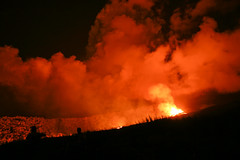Last week I was looking across at Dos d'Ane from Ilet Alcide (see
here), this week I was hiking from there!
 |
| Dos d'Ane village, Le Port in the distance |
Dos d'Ane (literally 'Donkey's back') is a farming village in the highlands above the town of
La Possession, at about 900-1000m altitude. From a visitor's point of view it is most well-known for Cap Noir and the Roche Verre Bouteille (literally 'Bottle Glass Rock'). Our hike started with a short walk from the car-park to the Cap Noir viewpoint, from where you can see the northern part of
Mafate.
 |
the northern part of Mafate seen from Cap Noir,
in the middle is Piton Cabris (1441m) |
At Cap Noir we came across the photographer
Luc Perrot, - I've
already shared several of his amazing photos on this blog. Here's one of the photographs he took from Cap Noir:
 |
| © Luc Perrot |
 |
| looking towards the Grand Bénare (centre) and the Maïdo |
 |
| looking west from Cap Noir |
After that we quickly gained about 200m in altitude as we hiked up to Roche Verre Bouteille. Altough the rock is shaped like a bottle, it actually gets its name from the
Reunion Creole term for "shard of glass".
 |
| Roche Verre Bouteille (slightly left of centre) (source) |
If you're looking for a short hike once you're at Roche Verre Bouteille you can loop back to the Cap Noir car-park, we however were heading to Plaine d'Affouches along a ridge-top hiking path.
 |
| unidentified plant - flowers like jasmine, fruit like coffee |
Despite recent rain the weather was magnificent and we had spectacular views across Mafate to the
Piton des Neiges.
 |
| looking across Mafate, Piton des Neiges back left, Grand Bénare far right |
 |
| close-up of Piton des Neiges |
Affouche is the local name for
Ficus densifolia, a plant of the fig family.
 |
| note the path steps to the left |
We could see the town of
Le Port far below.
 |
| view of Le Port from the hiking path |
We saw quite a few
Reunion Harriers (
papang) flying, and a few
tenrec hunters too, as the hunting season (mid-Febuary to mid-April) had officially just opened.
The closer we got to Saint Denis the thicker the vegetation became.
 |
| forest vegetation |
After almost 9 km of hiking we finally reached a dirt track from where we had a good view of the
Saint Denis river valley.
 |
| Saint Denis river valley |
Below us, at 700m, we could just see Ilet à Guillaume, a deserted hamlet which used to be a children's prison labour camp 1864-1879. About twelve children are buried there in a small cemetery.
 |
| close-up of Ilet à Guillaume |
Afterwards we only needed to walk down the flat (but winding) dirt track.
Three kilometres further on we stopped for lunch at a picnic shelter before being picked up by our transport and heading back to
Saint Denis.
 |
| looking along the Saint Denis river valley to Saint Denis |
 |
| one of many pic-nic tables next to the Plaine d'Affouches dirt track |
 |
| Plaine d'Affouches map |
See also:
Useful map:
- Saint Denis (La Reunion) IGN 1:25,000 topographic map 4402 RT
 |
| satellite view map of our hiking route |
If you enjoyed this post, you might also like:





